Kilimanjaro Trekking Marangu Route
The snow-covered peak looks increasingly challenging
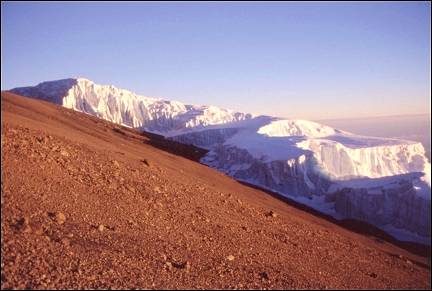
|
Via the Marangu route, the lightest and most popular (a.k.a. the Coca Cola route), to the top of Kilimanjaro. Through tropical rainforest to the Mandarahut, through a Jurrassic Park landscape to the Horombohut, through a desolate alpine desert higher up to the Kibohut and from Gilman's Point over the edge of the crater to the ice cap of the 5895 meter Uhuru Peak.
Travelogue & photos: Peter van Boheemen
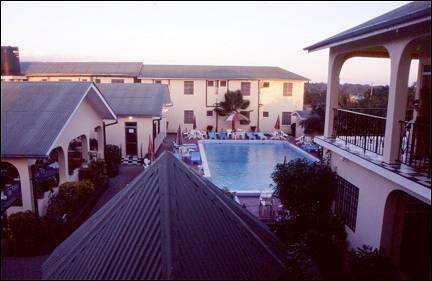
|
In Moshi is a fancy hotel from where we are going to make our Kilimanjaro expedition. The most important information in the briefing is: always listen to your guide and don't pay attention to tall tales of people who have been to the top already.
We take the Marangu route, also disparagingly called the "Coca-Cola route" because it is the easiest and most popular trail. I don't care how I reach the summit, as long as I do.
Tonight we're preparing ourselves for the trip. Part of our luggage will stay in the hotel - another part we brought especially for our climb of the Kilimanjaro: warm hats, fleece scarves, ski gloves, windbreakers and windtight pants...
Mandarahut
Tropical rain forest in the Kilimanjaro National Park
After breakfast we wait for the taxi, which arrives on time. A hostess accompanies us. The luggage goes on the roof, we get in the bus. The participants are all nationalities and ages.
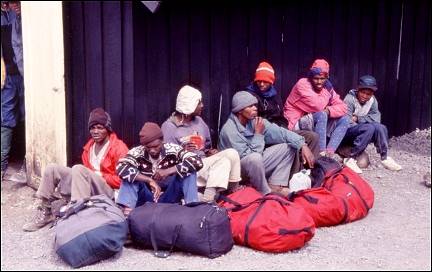
|
On the way we pick up our guide Felix. Also a cook, his assistent and three carriers. That means that every tourist has three people assigned to them, which makes the Kilimanjaro a huge employment project: every day 65 people start the hike up the mountain.
The climb starts in Marangu. Our luggage is brought to the carriers. Felix waits for our permits and when these are approved we can begin.
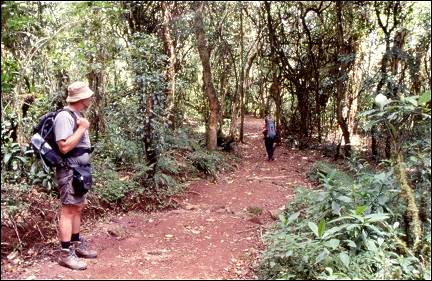
|
We walk through tropical rainforest. The guide keeps a slow pace. Hij points out monkeys and finds a small cameleon. The path is well paved and the hiking is easy.
But that is not the only reason to keep the path in good condition: erosion is also a factor. Smartly dug ditches control the drainage.
On a picnic spot we eat lunch: cold chicken, cake, banana and orange. This gives us enough energy for the last stretch.
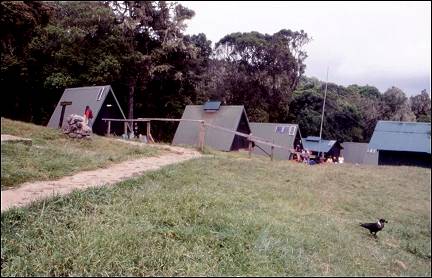
|
We pass by a small waterfall and see how the vegetation slowly changes: the trees get smaller, thinner and barer. After three hours we reach an altitude of 2700 meters.
Here the Kilimanjaro National Park begins and here is Mandara cabin where we spend the night. It is a cabin village with a section for the guides and one for the tourists. The cabins look sturdy and have each four clean beds. The only thing you have to bring is a sleeping bag. In the dining hall the cook serves us tea and fresh popcorn.
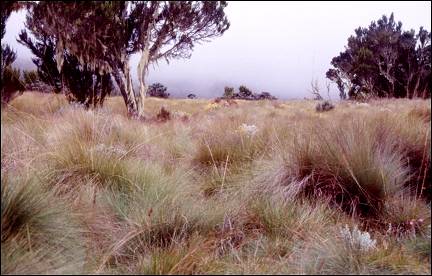
|
Kilimanjaro is an old, dead volcano. Near the Mandara cabin is an old crater. We walk towards it. Nature is very beautiful here and the old crater is clearly visible. Patches of fog and a few drops of rain make the surroundings look mysterious. Back at the camp it starts to rain harder.
There is coke and beer available for three times the regular prices. According to the information about acute mountain sickness (AMS) it's not wise to drink alcoholic beverages if you want to avoid getting sick, so we don't.
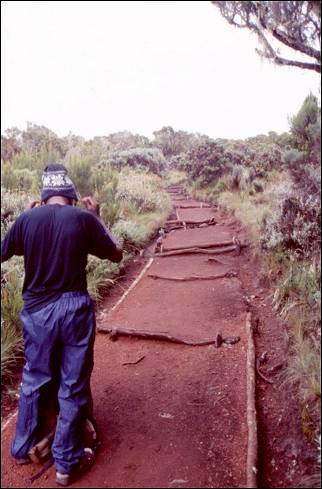
|
After dinner Felix informs us about tomorrow's program. We'll have breakfast at 7 am and will hike longer than today, but it won't be difficult.
In the cafeteria are four slightly overweight American ladies in their 50s. I ask Felix if he thinks they'll make it. He carefully looks around and says: "I don't expect them to, but you never know. Sometimes a fat person has the stamina to make it and a young person can fail because of AMS."
We share our cabin with two nice German kids. They have a bottle of vodka and offer us a drink. We forget our principles about alcohol and accept.
Horombo cabin
Big thistles, small brooks and giant lobelias
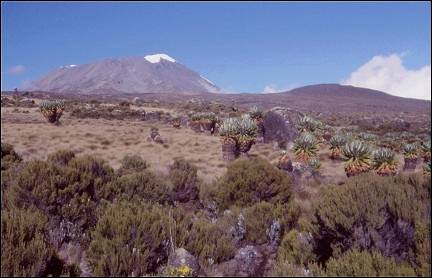
|
Today we also walk on a well-paved path. The flora is quite different. The tropical rainforest has made place for a Jurassic Park landscape, without the dinosaurs.
There are many colorful flowers, big thistles, small brooks and giant lobelias that look like palm trees.
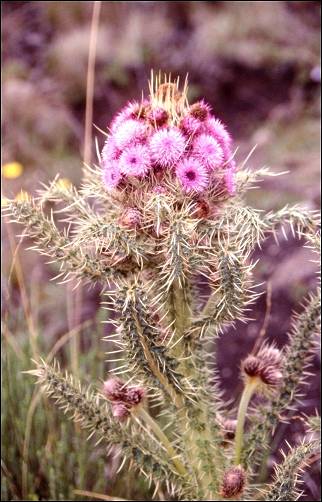
|
The fog makes the spectacular views even more restful. We arrive at our lunch picnic spot too early, so we take a coffee break without coffee.
During the last stretch to the Horombo Cabin at 3.720 meter, we are walking through fast moving clouds. It is a little colder here, but still comfortable enough for T-shirts and shorts.
We have ascended 1.020 meters today. Before we get a sleeping cabin assigned, we have to register.
When I open the door of our assigned cabin, I am scared to death: a man who is lying in bed on his back turns his fiery red face toward us and stares at me vacuously with bloodshot eyes.
I stammer: "We also sleep in this cabin, but eh, are you sick, or...?"
He tells us that he went to the top this morning; the temperature was minus 30 Centigrade and there was a snowstorm. And he wanted to be the first to reach the top at any price.
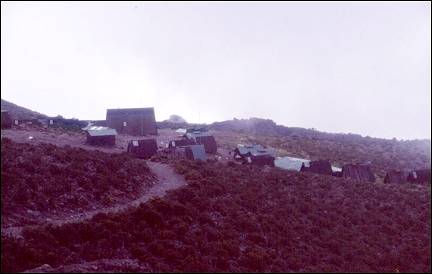
|
He looks terrible. I want to get to the top, but I don't want to look like this, so I get a little worried. A little later his friend arrives. He looks okay, no discoloration and that puts me at ease a bit.
Maybe the red man overdid it. My friend Cor notices later that his clothes aren't really suitable for this kind of trip: a torn fleece sweater, a thin workman's jacket and rubber boots.
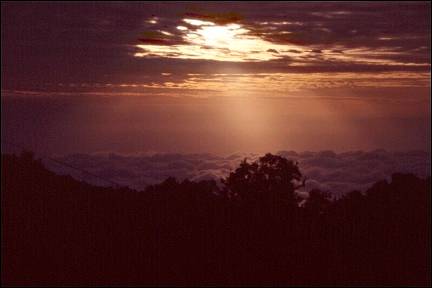
|
Felix tells us to climb a little further. We didn't book an extra day to become acclimatised, but by climbing a little now, we can achieve the same result and decrease the risk of AMS. We walk until our altimeters indicate 4000 meters and then we take a rest.
Back in Horombo I have an exorbitantly overpriced Coke and in the last rays of the sun I enjoy it extra.
After sunset we go to the dining hall. We meet a young Swiss couple who have been at the top this morning. They speak of extreme cold. We remain optimistic. If a couple of twenty-somethings can make it to the top, a couple of robust forty-somethings should have no problems, no?
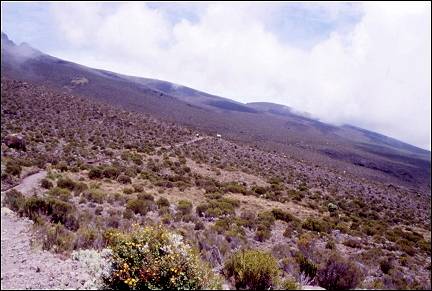
|
At least 15 mice are scuttling around in the dining cabin. They're not scary, but pretty with brown stripes on their backs. Unfortunately, one of them doesn't watch out while crossing and looses his life under the shoe of a waiter.
I keep myself awake with crossword puzzles until a quarter past nine. According to the man with the red face we won't be able to sleep tonight because of the cold. But it's not that cold at all. Still I lace myself up in my sleeping bag. Later that night I have to open it a little, because it is too warm. Now I am sure that Redface exaggerates and reassured I fall asleep again.
Kibo cabin
The landscape is bare, empty, rocky and desolate
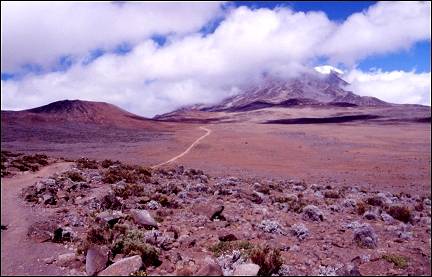
|
Today we don't have to get up early. The cook's food may not be great, but every morning he offers us a bucket with warm water to wash our faces. Today it's "Pole, pole," Swahili for "take it easy."
We are told to walk slowly to get acclimatised. It's wonderful to see the landscape change. During the first stretch we still see some vegetation.
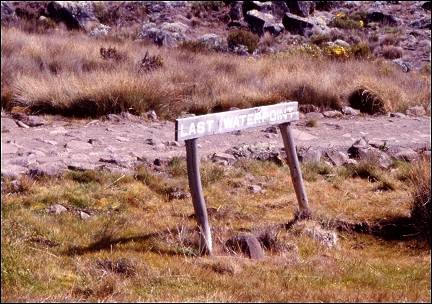
|
Near a small patch of marsh is the last watering place. Here we can still get water that, if boiled well, can be used as drinking and cooking water. After this point the landscape is bare, empty, rocky and desolate. There is a breeze blowing over the plain. For lunch we seek shelter between some rocks.
The snowy peak of the Kilimanjaro looks increasingly challenging. Today we also ascend 1000 meters. Because of the slow incline one hardly notices. Except for the last stretch where the path is a little steeper.
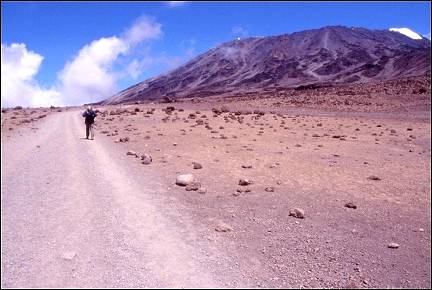
|
We also begin to notice the effects of height. At 4500 meter there is clearly less oxygen. Still the hike to the Kibo cabin at 4703 meters goes well. Even though my calves got sunburned today. The sun at this height is tricky.
Today some people have to rest on the bunk beds.
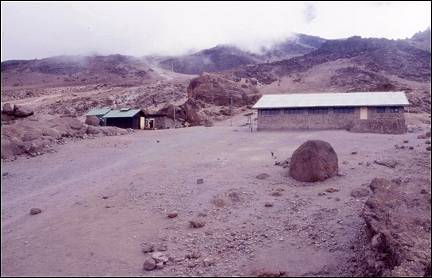
|
The Kibo cabin is different from the earlier two cabin villages. It consists of one big building with lots of bedrooms.
I take an acclimatising walk. After having ascended 350 meters I have to get back to be in time for dinner. Today there is only potatoe soup.
After dinner, 8.15 PM, we try to sleep a little, because we have to get up again at 11 PM to prepare for the climb to the top that starts at 12 in order for us to arrive at sunrise.
Sleeping is difficult. Because of the height my heart races. It's scary. When we get up, I feel better.
Uhuru Peak
Snow walls and glaciers in the red glow of dawn
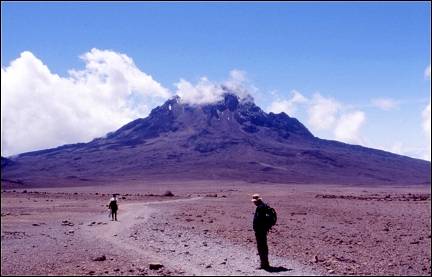
|
Today it's going to happen. We have to reach a height of 5.895 meters. Each tourist gets a guide assigned, because you shouldn't get lost in the dark in the freezing cold. And if you can't go on because of AMS, your guide will take you back to camp.
When we're just on our way, Felix' neck starts to bother him; he had a car accident a while ago. He gives me his flashlight, goes back to camp and sends a replacement.
Walking is hard in the dark. Stumbling on a stone I fall. Slowly, with little steps we zigzag up over an imaginary hairpin path. After a short while the drinking water is frozen.
Cor is having a hard time and wants to rest more often and longer. But the guides are unrelenting. Long rests are dangerous because of the risk of freezing. So he plods along. Our guides keep talking to him for encouragement.
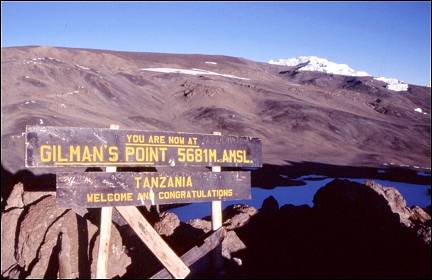
|
And that is not a luxury, because we have reached the first high point: Gillmans Point. Here is the 5.685 meters high crater edge. Another 200 meters and we will have reached the top of the roof of Africa. We follow the edge of the crater. At first it is level, but then we ascend again.
I am beginning to notice the effects of the altitude. I'm a little dizzy and I walk unsteadily. The temperature is minus 15 Centigrade with a strong wind. We want to rest a few more times, but the guides are afraid we'll freeze and urge us to keep walking. And they are right, of course.
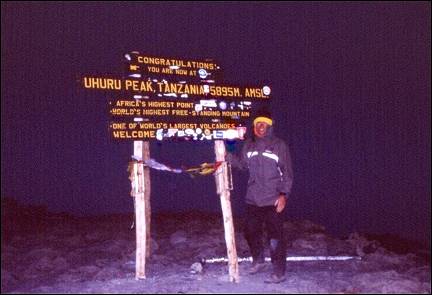
|
Also, the end is near. We can already see the Uhuru Peak sign. A little perseverance and we're there. It is still dark when we reach our ultimate goal. We use a flash to take the picture beneath the sign.
Sunrise is stunning, the snow walls and glaciers are immersed in the red glow of dawn. We must enjoy this, because doom scenarios predict that because of global warming within twenty years there won't be any snow left on the equator.
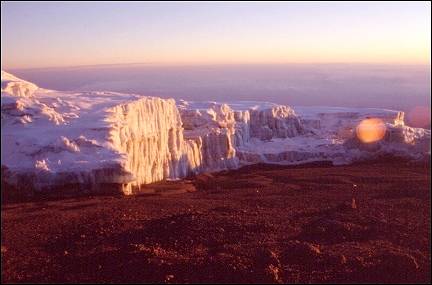
|
It's not easy to truly enjoy it: it's much too cold for that. Quickly we take pictures, so we will be able to see how wonderful it was to see the sun rise on the equator at an altitude of 6000 meters when we get home.
Now we have to get back ASAP to less wind, higher temperatures, more oxygen and water. The water in my bottle is almost solid frozen.
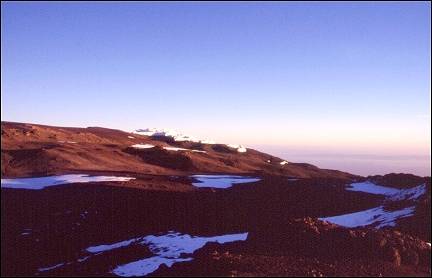
|
Walking down is easier, of course. The steep hillside is covered with grit. The guide says: "Just follow me" and kind of skis down on the grit. I try it and it is easy indeed.
When we get down, Felix is waiting to congratulate us. We rest for a while, eat a little and are ready to walk again. We walk down the mountain toward the Horombo cabin. We recover fast from tonight's exertion. In fact, Felix says: "This is going so well, we can walk all the way down to the Mandara cabin, so we'll be back in the hotel by noon tomorrow." We think of the swimming pool and a bottle of beer and agree.
Back to where we started
Glaciers in the morning, tropical rainforest in the afternoon
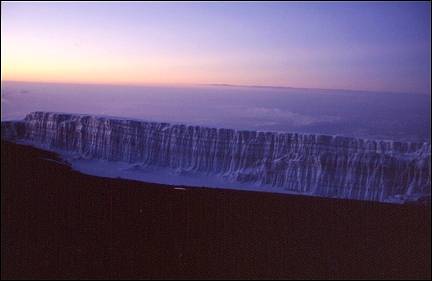
|
We stop at the Horombo cabin to rest and eat. Then we continue our walk. It's a special experience to see the landscape change this much in one day: in the morning glaciers, with a temperature of minus 15 Centigrade, in the afternoon tropical rainforest.
It's crowded in the Marango cabin. After dinner, for which we have to wait very long, we go to sleep immediately. We've been up for 22 hours and have been very active.
On the last day we only have to walk half a day. That is a good thing, because my legs are stiff now.
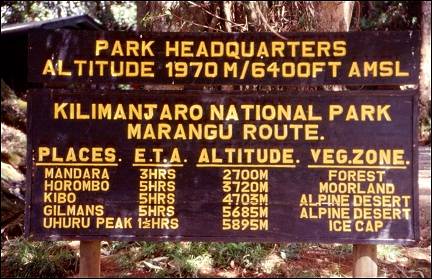
|
Towards the end of our hike we walk to a waterfall. A fresh jet of water patters down between the tropical green. And then the last few meters. We sign the registration book for the last time and get the certificate that we wanted.
Then we take the bus to the hotel for a wonderful shower, swimming pool and well deserved beer. There also is a masseuse in the hotel. We make an appointment for a massage. It seems to help, but the next day our leg muscles are stiff again. But we have reached our goal. They can't take that away from us.